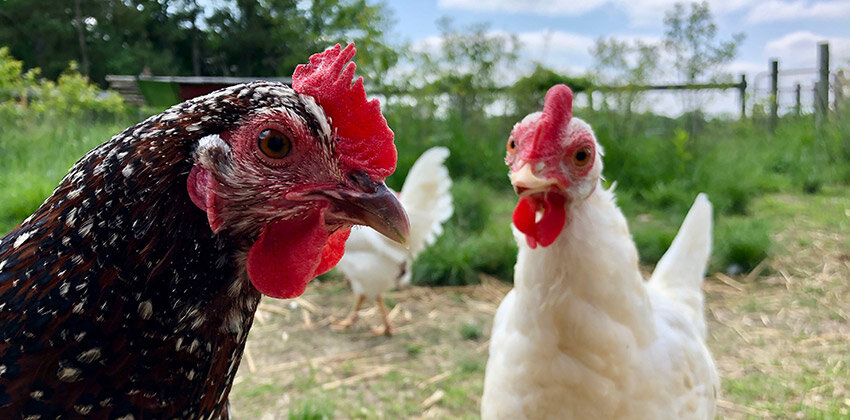Factory Farming: Chickens
By Barbara Hengstenberg for Piedmont Farm Animal Refuge
One doesn’t have to venture far onto the property of the Piedmont Farm Animal Refuge before the crowing and clucking of happy roosters and hens can be heard. Here, the social bonds and strong friendships between chickens are celebrated. Their complex and sophisticated communication resounds throughout the sanctuary.
Sadly, most chickens are not living in such comfortable and respectful environments. The majority of chickens are living on factory farms where, for instance, approximately 305 million layer hens produced around 73 billion eggs for human consumption in the United States in 2014. According to the American Egg Board’s website, “66 egg producing companies” represent “approximately 87 percent of total production.” Seventeen of those 66 companies house “greater than 5 million hens”. Around the 1950’s “broiler chickens” and “layer chickens” began to be bred separately for specific traits. “Layers” were designed to make eggs, and “broilers” were designed to make flesh. More than 8.5 billion chickens are raised and killed for meat each year in the U.S.
In terms of agribusiness, making the most cost-efficient layer hen requires growing them quickly (through genetic manipulation and drugs), packing them in tightly, measuring how little they can eat, and monitoring how sick they can get without dying. For example, most egg-laying hens are allowed less space to live in (67 square inches) than the size of your laptop computer screen.
The lives of layer hens start in hatcheries where they are born in metal incubators and never meet their mothers. The chicks are roughly handled and sorted by gender on a fast moving conveyor belt. Only the females are able to lay eggs, so the “useless” male chicks are killed by being ground up alive or by being tossed into trash bags where they suffocate. Few people who eat eggs realize they are supporting this immense cruelty.
The female chicks are put in cages with six to eight other hens, and the cages are lined up in rows and stacked in tiers in huge warehouses. Such close quarters would aggravate anyone, and unsurprisingly, aggression is high. To keep the hens from killing each other, their beaks are cut off with hot blades when they are still young. Debeaking causes chronic pain throughout their short lives. The cages they are kept in have sloped floors, which prevent the birds from sitting and causes immense foot and joint pain. It is common for some of the hens’ toenails to grow around the wires of the caging, completely immobilizing them.
Many hens living in such extreme confinement die from shock, reproductive complications due to being forced to produce over 265 eggs a year (many times the number they would naturally lay), or mishaps from being stuck inside the wire caging. While hens in natural settings can live more than ten years, those who live in factory farms are killed after one year when their egg production wanes. At this point, their bones are so depleted of calcium from having to produce calcium-rich eggshells that they break and bruise easily. Because of this, meat from layer hens is used in processed foods (such as chicken soup) and animal feed, where the bruising is less noticeable.
“Broiler chickens” are now modified to grow several times faster and much larger than their ancestors. Daily growth rates have increased between 300 and 400 percent over the past 50 years. At only 37 days young, baby birds—still soft and peeping—have adult bodies that weigh heavily on their immature skeletons and cause many of them to become completely immobilized. If a human grew at the same rate as a chicken bred for meat, they would weigh 349 lbs by the age of two. With the increased interest in white breast meat, chickens have been bred selectively to grow larger breasts, which cause them to lean over and drag their heavy breasts on the ground. “Rapid growth” unsurprisingly leads to further joint damage, poor bone health, metabolic disorders, chest sores, and lameness.
Because of selective breeding, genetic manipulation, and extreme drug regimens, these birds suffer and die in large numbers. Each year in the US, over 90 million birds are killed or die from leg problems, and an estimated one to four percent (85,000,000 to 340,000,000) die from heart attacks associated with their rapid growth. Overcrowding, artificial lighting and poor air quality (including high concentrations of ammonia) are additional factors leading to health and welfare problems. Those who survive to 42 days of age are then killed for meat.
At least ninety-five percent of chicken meat comes from factory farms. But even on smaller farms most chickens suffer inhumane conditions and face major problems affecting their welfare. Smaller egg-producing farms also contribute to major welfare problems that affect chickens. As long as animals are viewed as commodities to be used by humans, their needs and interests will never out-weigh gain in profit by farmers of all kinds.
Here at the Refuge, fifteen chickens, including Isa and Hera, came to us from Brooklyn, NY, where they were going to be used in a religious ritual. In this ritual, chickens are traditionally swung around in circles by their wings before being killed. Luckily, Isa, Hera and their friends were relinquished to a group of protestors. Their lives at the Refuge include pasture and woods to roam, a safe warm house, two meals a day—including a daily kale salad!—and lots of love from chicken and human friends alike.
Resources:
American Egg Board, The Egg Business. 2015.
Bauer, G. Farm Sanctuary: Changing Hearts and Minds About Animals and Food. New York: Simon & Schuster, 2008. pp. 149-150, 153, 155.
Hatkoff, Amy. The Inner World of Farm Animals: Their Amazing Social, Emotional, and Intellectual Capacities. NY: Henry N. Abrams, Inc., 2009. pp. 21-41.
The Humane Society of the United States. An HSUS Report: The Welfare of Animals in the Chicken Industry. December 2013.
Safran Foer, J. Eating Animals. New York: Little, Brown and Company, 2009. pp. 48, 79,109.
U.S. Department of Agriculture, National Agriculture Statistics Service. Chickens and Eggs. February 2015.
Woodstock Farm Sanctuary > Learn > Animals Used for Food > Chickens for Meat


